How to Train Clients With a Knee Replacement (Step-by-Step Guide)
Training clients with knee replacements can open up a new client base for a personal trainer. But, it’s important that you have the proper tools to train someone with a knee replacement effectively. Using certain personal training software features can help you train clients with knee replacements. Find out how to train clients with a knee replacement and learn about what tools you’ll need to train someone with a knee replacement in this step-by-step guide.
- Personal trainers should have a strong understanding of lower extremity mechanics when training clients with a knee replacement.
- Postoperative exercises for knee replacements start by restoring stability and eventually promote a functional range of motion.
- Incorporating mobile workout and assessment software can help improve the rehabilitative process for clients with a knee replacement.
Breaking into training special populations, like training clients with a knee replacement, can be a rewarding way for personal trainers to add a new stream of revenue to their fitness businesses.
To train clients with a knee replacement, it’s important that you’re not only well-versed in knee replacements, but that you have the tools in place to make your training as effective as possible; that’s where personal training software comes into play.
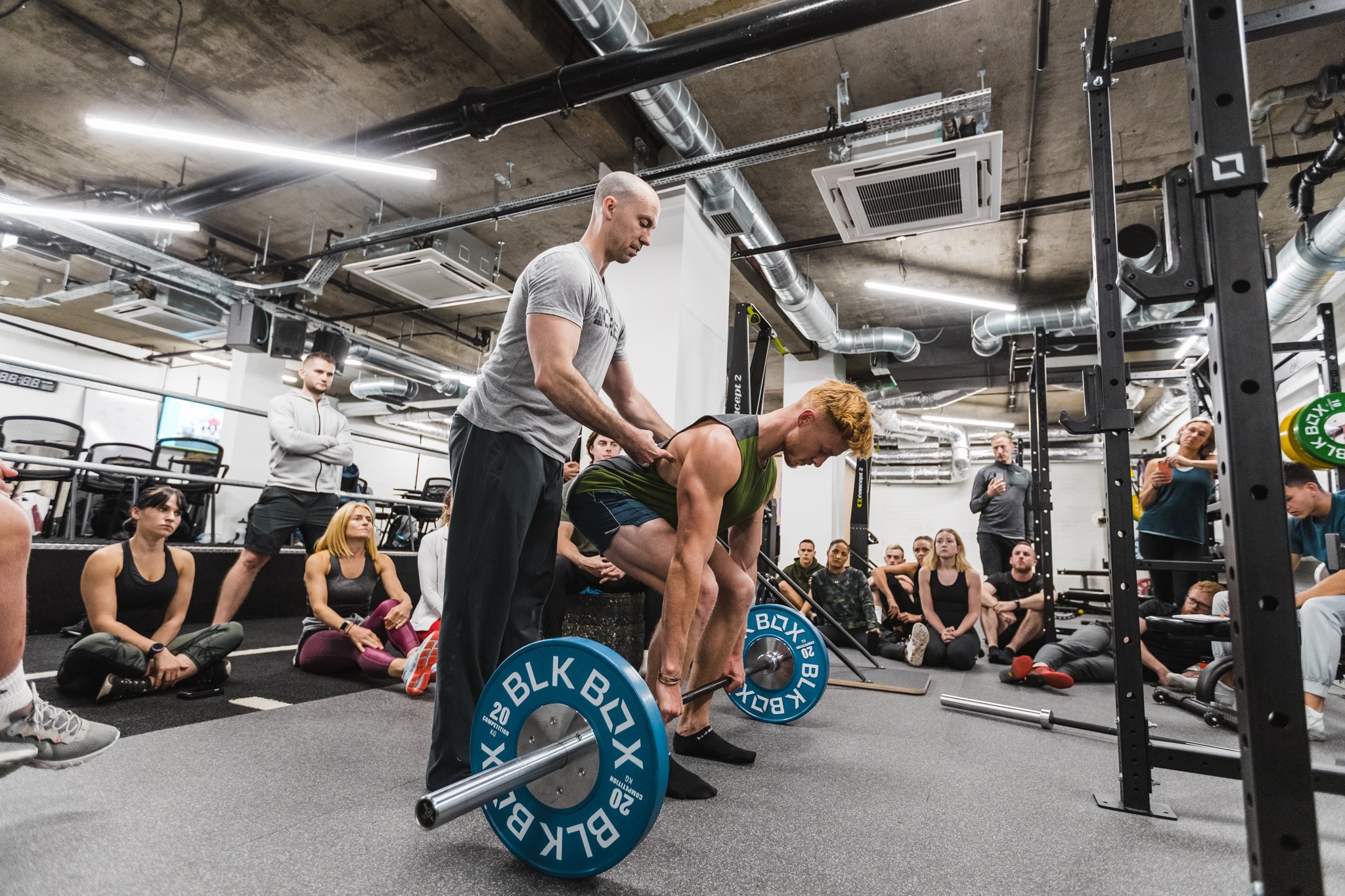
By taking advantage of the features that personal training software has to offer, you can train clients with knee replacements in a way that works for them, not against them.
To learn more about the Exercise.com personal training software platform, book a demo today!
How to Train Clients With a Knee Replacement
To learn how to train clients with a knee replacement, it’s imperative that you have a thorough understanding of what a knee replacement is and why it’s important to follow certain procedures with these clients.
What is a knee replacement?
A knee replacement, or knee arthroplasty, is a surgery that replaces all or some of the bones and soft tissues that form the knee joint. Most notably, the distal end of the femur (femoral condyles), the meniscus, and the proximal end of the tibia will be replaced with material to help provide a more articulate joint after years of wear and tear.
Patients who opt to undergo knee replacements are usually experiencing significant pain due to friction between the worn surfaces of the femur and the tibia. Over time, the cartilaginous tissue between the two bones wears down. When this happens, everyday movements like walking, climbing stairs, and even getting dressed can become a task.
With so much pain and inflammation, many people will succumb to a more sedentary lifestyle and experience atrophy in surrounding muscles such as the quadriceps, hamstrings, and calves. Beyond this, the sedentary lifestyle could further contribute to obesity or other problems.
There are even some age and gender factors that suggest an increased likelihood of knee replacements for some. For these reasons, it’s valuable to have extensive knee knowledge when working with clients following a knee replacement.
Do you need to be certified to train clients with a knee replacement?
The rehabilitation process for knee replacements has come a long way over the years. Nowadays, knee replacement surgeries can be outpatient procedures in which patients will walk on the same day. There will be some proprioceptive changes, but patients won’t have to relearn how to walk after knee surgery.
Before you can effectively train someone with a knee replacement, it’s important to get credentialed to optimize your program design. It would be preferred to have an advanced certification such as:
- ACSM Clinical Exercise Physiologist (EP-C)
- ACE Medical Exercise Specialist
- NSCA Special Populations Specialist (CSPS)
With any of the above certifications, you’ll learn how to handle clients with a myriad of musculoskeletal disorders like rheumatoid or osteoarthritis. While not identical, these conditions present many of the same symptoms and limitations that affect clients who have recently had knee replacements.
In any case, if you want to expand your potential outreach with clients, you’ll want to be prepared to accommodate clients who have had a knee replacement. A big component of your preparation will be learning exercises to perform before a total knee replacement and how they differ from exercises performed after a knee replacement.
Training Clients After a Knee Replacement
Assuming a client has experienced chronic knee pain, there’s a good chance they’ve been informed they should perform certain exercises before knee replacement. Many surgeons provide patients with a total knee replacement exercise guide, similar to OrthoInfo.
The truth is, early postoperative exercises, or phase 1 total knee replacement exercises, will be similar to the exercises you’ll do before a knee replacement. Most total knee replacement exercises are designed to maintain the stability or strength in nearby muscles. Some of those exercises include:
- Straight Leg Raises (Hip Flexors/Quadriceps)
- Ankle Pumps (Calves)
- Knee Straightening (Quadriceps)
- Knee Bends (Hamstrings)
There are different ways to perform these exercises depending on a client’s abilities. Some clients won’t be able to get on the floor. As a trainer, you’ll have to have alternative methods to perform many of these low-intensity leg exercises if you want to train clients with knee replacements.
Not all clients will progress at the same rate, so you’ll need to use caution before getting to other advanced total knee replacement exercises. You’ll see above that most of the phase 1 knee replacement exercises use bodyweight and limited range of motion.
Advanced knee replacement exercises will further emphasize restoring strength throughout a more complete range of motion. This would include more traditional movements, albeit at lower intensities, to help get back to everyday life. Examples could be chair squats, leg presses, low step-ups, and other exercises, as tolerated.
If a client experiences pain throughout a specific range of motion, terminate that exercise and move on to something more appropriate. To minimize these instances, there are a handful of knee replacement exercises to avoid, such as:
- Jump Squats
- Running
- Jumping Jacks
- Skipping
- Agile Sports
In short, when you’re training a client with a knee replacement, especially a recent one, you’ll need to minimize the impact on that knee. Keeping your clients safe can prolong their time with you for more stable revenue and a more satisfying result.
Understanding the Importance of Exercise After Knee Replacement Surgery
Exercise plays a crucial role in the rehabilitation process for clients who have undergone knee replacement surgery. It helps improve strength, flexibility, mobility, and overall function of the knee joint. By understanding the significance of exercise, both clients and trainers can work together to achieve optimal outcomes.
After surgery, the soft tissues surrounding the knee undergo a healing process. Exercise helps stimulate blood flow, reducing the risk of blood clots and promoting faster healing. It also aids in rebuilding strength in the muscles that support the knee, such as the quadriceps and hamstrings.
Beyond physical benefits, exercise also provides psychological benefits for clients with a knee replacement. It helps boost confidence, alleviate anxiety, and improve overall well-being, which are essential elements in the recovery process.
The Benefits of Exercise for Clients With a Knee Replacement
There are numerous benefits that exercise offers for clients with a knee replacement. Firstly, regular physical activity helps improve joint mobility and flexibility. It helps prevent stiffness and promotes better range of motion in the knee joint.
Exercise also aids in managing weight, which is crucial for reducing stress on the knee joint. Maintaining a healthy weight helps minimize the risk of additional strain and wear on the artificial joint, thereby increasing its longevity.
Furthermore, exercise enhances cardiovascular health, which is important for overall fitness. Engaging in activities that elevate heart rate and increase endurance not only benefits the cardiovascular system but also supports weight management and aids in mood regulation.
Preparing Clients for Exercise Post-Knee Replacement Surgery
Before beginning any exercise program, it is essential to assess the client’s health and functional abilities. Discuss with the client’s medical team to understand any specific limitations or precautions that need to be considered during the training process.
Once cleared for exercise, begin with gentle range of motion exercises to help improve knee flexibility. This can include simple movements such as ankle pumps, leg slides, and heel slides. Gradually progress to more challenging exercises to target strength and endurance.
It is crucial to individualize exercise programs based on clients’ abilities and goals. Consider factors such as age, overall fitness level, previous exercise experience, and specific challenges related to the knee replacement surgery. With a tailored approach, clients can safely and effectively progress towards their desired outcomes.
Tailoring Exercise Programs for Clients With a Knee Replacement
When designing exercise programs for clients with a knee replacement, it is important to focus on strengthening the muscles surrounding the knee joint. This can include exercises targeting the quadriceps, hamstrings, hip abductors, and calf muscles.
Resistance training, such as leg presses, lunges, and step-ups, can help build muscular strength and endurance. However, it is vital to start with lighter weights and progress gradually to avoid placing excessive strain on the knee joint.
Additionally, incorporating exercises that improve balance and stability is crucial for preventing falls and promoting confidence in clients. This can involve single-leg stands, heel-to-toe walking, and proprioceptive exercises using balance pads or unstable surfaces.
Key Considerations for Training Clients With a Knee Replacement
While it is important to challenge clients during exercise sessions, it is equally important to listen to their bodies and respect their limitations. Pain or discomfort during exercise should not be ignored and should be communicated to the trainer or healthcare provider immediately.
When creating exercise programs, incorporate a variety of modalities to keep clients engaged and motivated. This can include not only traditional strength training but also low-impact activities such as swimming or cycling to reduce joint stress.
Furthermore, always ensure proper warm-up and cool-down routines are included in every workout to minimize the risk of injury and promote recovery. Stretching exercises before and after the main workout can help improve flexibility and reduce muscle soreness.
Effective Techniques for Strengthening the Knee After Surgery
Strengthening exercises play a pivotal role in the rehabilitation process for clients with a knee replacement. One effective technique is progressive resistance training, where weights or resistance bands are gradually increased as strength improves.
Isometric exercises, which involve contracting the muscles without joint movement, can also be beneficial in early stages of recovery. These exercises can include quad sets, hamstring sets, and gluteal sets. They help activate and strengthen the muscles surrounding the knee joint without placing excessive stress on the newly replaced joint.
Incorporating functional exercises that mimic everyday movements is another effective technique. This helps clients regain strength and confidence in performing daily activities such as walking, bending, and climbing stairs.
Building Mobility and Flexibility in Clients With a Knee Replacement
To improve mobility and flexibility in the knee joint, a combination of stretching exercises and range of motion movements can be utilized. Dynamic stretching exercises, such as leg swings and walking lunges, help increase joint mobility and improve muscle flexibility.
Passive range of motion exercises, where the joint is moved by an external force, can be used to enhance flexibility. This can include gentle stretches performed by the client or assisted by a trainer or physical therapist. Gradually increasing the range of motion over time supports continual progress.
It is important to note that stretching should be performed gently and without force. Avoid overstretching the joint or applying excessive pressure, as this can lead to injury or strain.
Safe and Progressive Cardiovascular Training for Clients With a Knee Replacement
Cardiovascular training is an integral part of any exercise program, including for clients with a knee replacement. It helps improve heart health, burn calories, and maintain overall fitness.
Low-impact exercises are preferred to minimize stress on the knee joint. Activities such as cycling, swimming, or using an elliptical machine are great options. These exercises provide cardiovascular benefits without placing excessive strain on the knee.
When designing cardiovascular workouts, start with shorter durations and lower intensity levels, gradually increasing both as the client’s fitness improves. Listen to the client’s feedback and adjust the intensity and duration based on their comfort and progress.
Incorporating Balance and Stability Exercises in Rehabilitation Programs
Balance and stability exercises are essential for clients with a knee replacement to improve proprioception and reduce the risk of falling. These exercises engage the muscles responsible for joint stability and help clients regain confidence in their ability to maintain balance.
Examples of balance and stability exercises include standing on one leg with eyes closed, performing single-leg squats, or using stability balls or balance boards. These activities challenge the body’s equilibrium and improve overall stability.
When incorporating balance exercises, ensure that clients have appropriate support or supervision to prevent falls or injuries. Begin with simple exercises and progress gradually as balance and confidence increase.
Preventing Common Injuries in Clients With a Knee Replacement During Training
While exercise is beneficial for clients with a knee replacement, it is important to prioritize safety and prevent common injuries. One common injury is overuse or repetitive strain. To prevent this, ensure that exercise programs are well-balanced and allow for adequate rest and recovery between sessions.
Proper form and technique are crucial in preventing injuries. Educate clients on the correct posture, alignment, and movement patterns for each exercise. Monitor their form closely and provide feedback and corrections as needed.
Incorporating a gradual progression plan is key to preventing injuries. Gradually increase the intensity, duration, and complexity of exercises over time, allowing the body to adapt and reduce the risk of strain or overload.
Addressing Pain Management and Discomfort During Exercise with a Knee Replacement
Pain and discomfort may be experienced during exercise by clients with a knee replacement. It is important to effectively manage pain to ensure a safe and productive training experience.
Encourage clients to communicate any pain or discomfort they may experience during or after exercise. This allows for modifications or adjustments to be made to the exercise program to minimize pain while still providing a challenging workout.
Applying ice or heat to the knee joint before and after exercise can help reduce inflammation and alleviate discomfort. Pain medications prescribed by healthcare providers can also be taken prior to exercise, if recommended.
Monitoring Progress and Adjusting Exercise Programs for Optimal Results
Regularly monitoring clients’ progress is crucial for adjusting exercise programs to ensure optimal results. This can be done through various methods such as tracking strength gains, range of motion improvements, or cardiorespiratory endurance.
Documenting progress and reassessing goals periodically helps maintain motivation and provides guidance for making necessary adjustments. This ensures that exercise programs continue to challenge clients and facilitate ongoing improvements.
It is important to be flexible and adaptable as clients with a knee replacement may have different rates of progress. Adjusting exercise volumes, intensities, or exercises themselves based on individual needs and comfort levels is key to achieving successful outcomes.
Working with Physical Therapists to Enhance Recovery and Performance After Knee Replacement Surgery
Collaborating with physical therapists can significantly enhance a client’s recovery and performance after knee replacement surgery. Physical therapists have specialized knowledge and expertise in rehabilitative techniques specific to knee surgeries.
Working in conjunction with physical therapists allows for a comprehensive and cohesive approach to rehabilitation and training. By sharing information, goals, and progress, trainers can design exercise programs that complement and build upon the work done in physical therapy sessions.
Regular communication with physical therapists ensures a seamless transition from rehabilitation to training, promoting a continuum of care to maximize the client’s potential for recovery and performance.
Psychological Considerations and Motivation Strategies for Clients with a Knee Replacement
The psychological well-being of clients with a knee replacement is just as important as their physical recovery. The surgery and rehabilitation process can be challenging both physically and emotionally.
Motivation strategies such as setting realistic goals, celebrating achievements, and providing positive reinforcement are crucial in keeping clients engaged and committed to their exercise programs. Understanding their motivations and interests can help tailor workouts to their specific preferences.
Additionally, providing a supportive and encouraging environment can foster a positive mindset and help clients overcome any psychological hurdles they may face during their recovery journey.
Training clients with a knee replacement requires a comprehensive and individualized approach. Understanding the importance of exercise, tailoring programs, and considering key factors such as pain management, psychological considerations, and collaborative work with physical therapists are crucial for successful outcomes.
By implementing safe and progressive exercise techniques, trainers can help clients improve strength, flexibility, mobility, cardiovascular health, balance, and stability. Together, trainers and clients can work towards enhancing recovery and performance after knee replacement surgery, ultimately leading to an improved quality of life.
One important aspect to consider when training clients with a knee replacement is the use of assistive devices. Depending on the individual’s needs and abilities, trainers may need to incorporate the use of crutches, canes, or walkers during certain exercises to provide additional support and stability.
In addition, it is crucial for trainers to stay up-to-date with the latest research and advancements in knee replacement rehabilitation. This includes understanding new surgical techniques, rehabilitation protocols, and evidence-based exercise interventions that can optimize outcomes for clients. By staying informed and continuously expanding their knowledge, trainers can provide the most effective and up-to-date guidance to their clients.
What exercise would you avoid for a client with a knee replacement?
For a client with a knee replacement, high-impact activities such as running, jumping, or any sport that involves sudden starts, stops or turns should generally be avoided, as they can put too much stress on the replaced knee.
How do you train clients with bad knees?
Training clients with bad knees should focus on low-impact activities that can strengthen the muscles surrounding the knee, such as swimming, cycling, or using an elliptical machine. Strengthening the hips, quads, and hamstrings can also help provide support to the knee.
What is the best exercise equipment after knee replacement?
After a knee replacement, exercise equipment that allows for low-impact and controlled movements, such as stationary bikes, elliptical machines, and resistance bands, can be beneficial.
How do you train after knee surgery?
Training after knee surgery should be done under the guidance of a physical therapist or a fitness professional experienced in post-surgery rehabilitation. Starting with gentle range of motion exercises and gradually progressing to strengthening exercises as healing allows is key.
What activities are prohibited after knee replacement?
Activities typically prohibited after knee replacement include high-impact sports, heavy lifting, and any activity that involves twisting or pivoting on the replaced knee.
What exercises can you do with a knee replacement?
Exercises that can be done after knee replacement (and with the approval of a healthcare provider) might include cycling, swimming, walking, leg presses, and seated leg extensions.
What exercises are hardest on knees?
Exercises that can be hard on the knees include deep squats, lunges, high-impact activities such as running or jumping, and any exercises that involve sudden twisting or turning movements.
What leg exercises can I do with bad knees?
With bad knees, exercises such as low-impact cardio (like cycling or swimming), leg presses, seated leg extensions, and hamstring curls can help to strengthen the surrounding muscles without placing excessive stress on the knee.
What is the best exercise for seniors with bad knees?
For seniors with bad knees, low-impact activities such as swimming, cycling, tai chi, or chair yoga can be beneficial. Balance exercises can also be important for improving stability and preventing falls.
What is passive exercise after knee replacement?
Passive exercise after knee replacement involves moving the joint without the patient’s muscles being actively involved. This might involve a therapist or a machine moving the joint, or the patient using their other leg or arm to move the affected joint.
Are there permanent restrictions after knee replacement?
Permanent restrictions after knee replacement often include avoiding high-impact sports and activities that involve jumping, pivoting, or twisting on the replaced knee. However, the exact restrictions may vary depending on the individual’s overall health, the type of replacement, and the advice of their healthcare provider.
Can you lift weights with knee replacements?
Light to moderate weight lifting can often be resumed after knee replacement surgery, with the approval of a healthcare provider. However, heavy leg lifts or any lifting that places significant stress on the knees should generally be avoided.
Are squats OK after knee replacement?
Shallow squats with proper form may be OK after knee replacement, but deep squats are often discouraged due to the stress they place on the knees.
What is the most important thing to do after knee surgery?
The most important thing to do after knee surgery is to follow the advice of your healthcare provider, which often includes regularly performing prescribed physical therapy exercises, taking prescribed medications as directed, and gradually increasing activity levels as healing allows.
Can you overdo physical therapy after knee replacement?
Yes, it is possible to overdo physical therapy after knee replacement. It’s important to follow the guidance of your physical therapist, to balance rest and
rehabilitation, and to avoid any exercises or activities that cause pain beyond a mild level of discomfort.
What yoga poses should you avoid with knee replacement?
Yoga poses to avoid with a knee replacement might include lotus or half-lotus, deep squats or lunges, and any poses that require deep knee bends or twisting of the knee.
Can exercise delay knee replacement?
Regular, low-impact exercise that strengthens the muscles surrounding the knee can help to support the joint and may potentially delay the need for knee replacement. However, once the knee joint is significantly damaged, exercise alone is unlikely to reverse the need for replacement.
Can you kneel or squat after knee replacement?
Kneeling is often uncomfortable after knee replacement and is generally discouraged. Squatting, particularly deep squatting, is also typically discouraged due to the stress it places on the replaced knee.
Can you lift weights with a knee replacement?
Light to moderate weight lifting can often be resumed after knee replacement surgery, with the approval of a healthcare provider. However, heavy leg lifts or any lifting that places significant stress on the knees should generally be avoided.
Software Tools for Training Clients With a Knee Replacement
When you’re learning how to train someone with a knee replacement, you’ll need to be more prepared than you would if you were working with your average Joe.
Workout Software for Clients With a Knee Replacement
The day in the life of a personal trainer isn’t for the faint-hearted. Most trainers work long days with less planning than they truly need. This leads to prescribing random exercises on the go instead of truly prescribing the best program for your clients.
It’s not as effective, or as safe, to create workouts without preparation for clients with special needs. Thankfully, Exercise.com’s versatile workout software allows trainers to create workouts and schedule them to be delivered at a more opportune time.
This software also allows trainers and clients to log and track workouts, all with complimentary analysis features so you can see progress or regression. Workout software can help improve your organization, reliability, and accountability for your clients.
Fitness Assessments for Clients With Knee Replacements
Workouts are important, but fitness assessments help prepare you to program for your clients. This is especially important when working with someone who’s had a knee replacement. Exercise.com offers functional fitness assessment software that helps trainers create and implement fitness assessments to better gauge a client’s abilities.
When assessing a client with a knee replacement, you’ll be able to measure and track things like range of motion, balance, strength, and anything else you feel fit for your client. As they progress, you can even automate assessments so that your clients can conduct and log them on their own.
Expense is a concern for clients, this is why many clients end physical therapy to work with a personal trainer. Eventually, they might want to cut costs even further. By providing accessible resources like fitness assessments and personalized workouts, you’ll be able to maximize retention and overcome financial barriers.
Customizable Exercise Library for Clients With a Knee Replacement
If your knee replacement client does decide to work more independently, it doesn’t necessarily mean there has to be a major downgrade in the quality of training they receive. Sure, distance training isn’t quite as personal, but personal trainers can provide their clients the resources they need to continue being successful. Happy clients stick around.
Exercise.com’s customizable exercise library offers clients a written and visual description of any exercise you want to prescribe. This is important when prescribing exercises after a knee replacement. With generic names like “knee bends” and “leg lifts”, clients could easily become confused about the desirable technique used to perform these movements.
They’ll be able to access your exercise library from a custom-branded fitness app anywhere, anytime. This helps improve accessibility and functionality to continue serving your clients, even if you aren’t around to help. These supplemental resources help to prevent many of the common barriers to exercise.
Training Clients With a Knee Replacement: The Bottom Line
Training clients with a knee replacement requires a lot more than just general knowledge. It requires education, empathy, and a host of software tools built with customization and adaptation in mind.

To learn more about how Exercise.com can help you train clients with the best personal training software to run your entire fitness business, book a demo today!
Creating Training Plans for Clients with a Knee Replacement
Here’s how you can help your clients accomplish their goals by using workout plan creator software to create workout plans, run fitness challenges, offer online workout groups, message clients, and more, all from your very own custom branded fitness apps.
Exercise.com stands out as an all-in-one fitness business management software with comprehensive workout plan sales capabilities. The robust member management, billing & invoicing, and unique fitness assessment tools offer a one-stop solution for fitness business needs. Here’s just some of what you can do with the Exercise.com platform:
Engage with clients via automations.
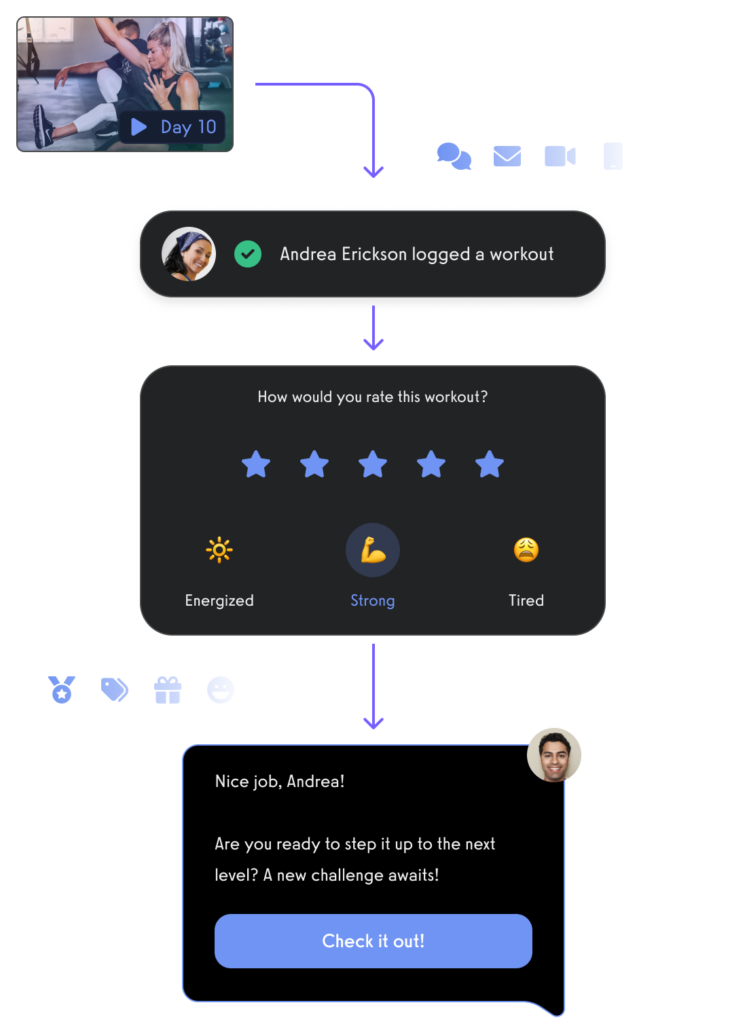
Manage leads with a fitness CRM.

Create and send fitness assessments with ease.
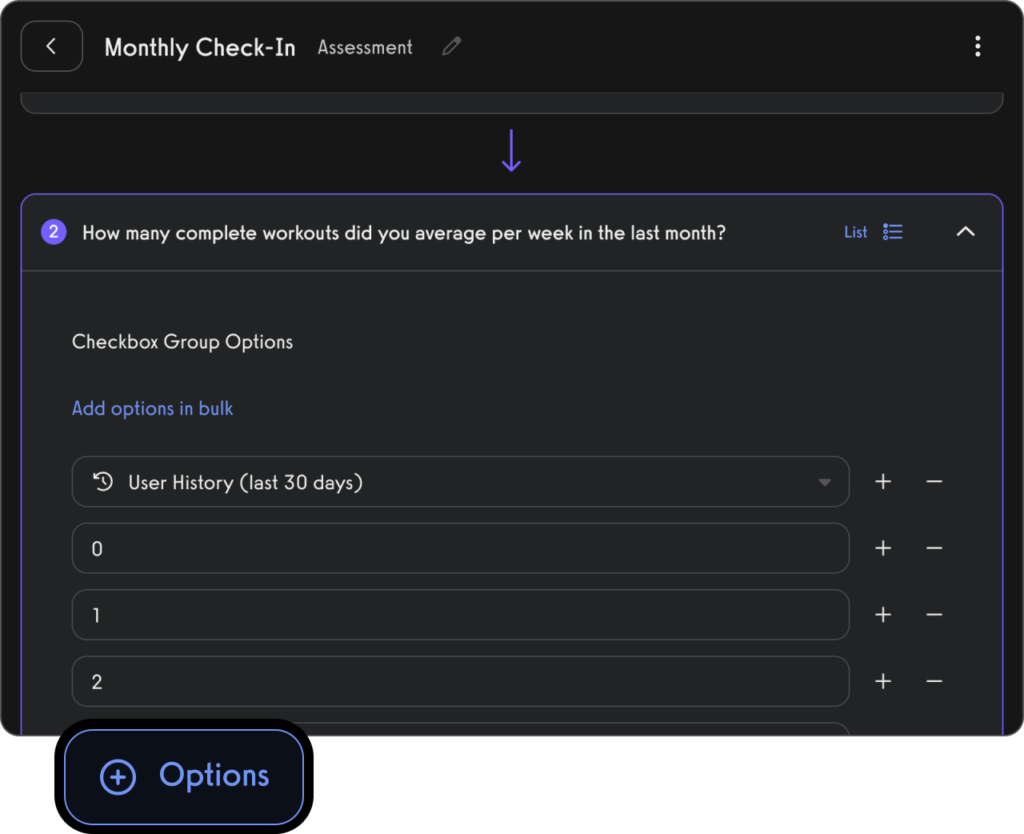
Use fitness habit tracking to inspire and motivate personal training clients (in-person and remote).

Use fitness progress photos to engage with clients.
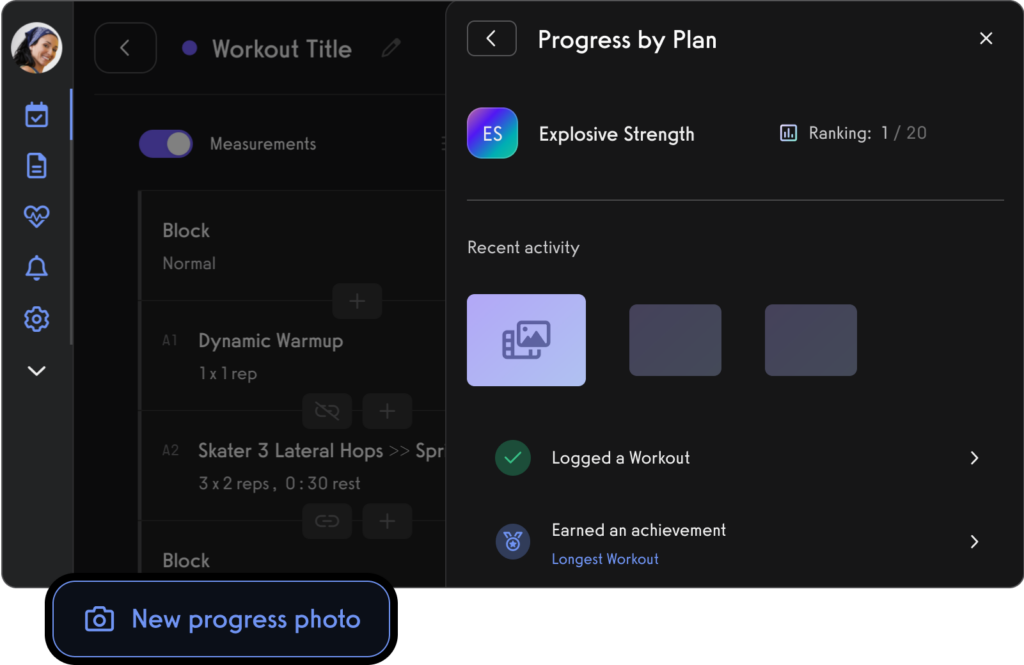
Use fitness leaderboards to track performance and inspire healthy competition.

Use the exercise demonstration video library or create your own custom exercise demonstration videos.

Create workout plans for parents and dependents, teams and more.

Manage personal training clients with ease.

Book appointments for clients (Read More: Best Gym Booking Software)

Create classes and fitness groups

Manage fitness challenges (Read More: 100+ Fitness Challenge Ideas)
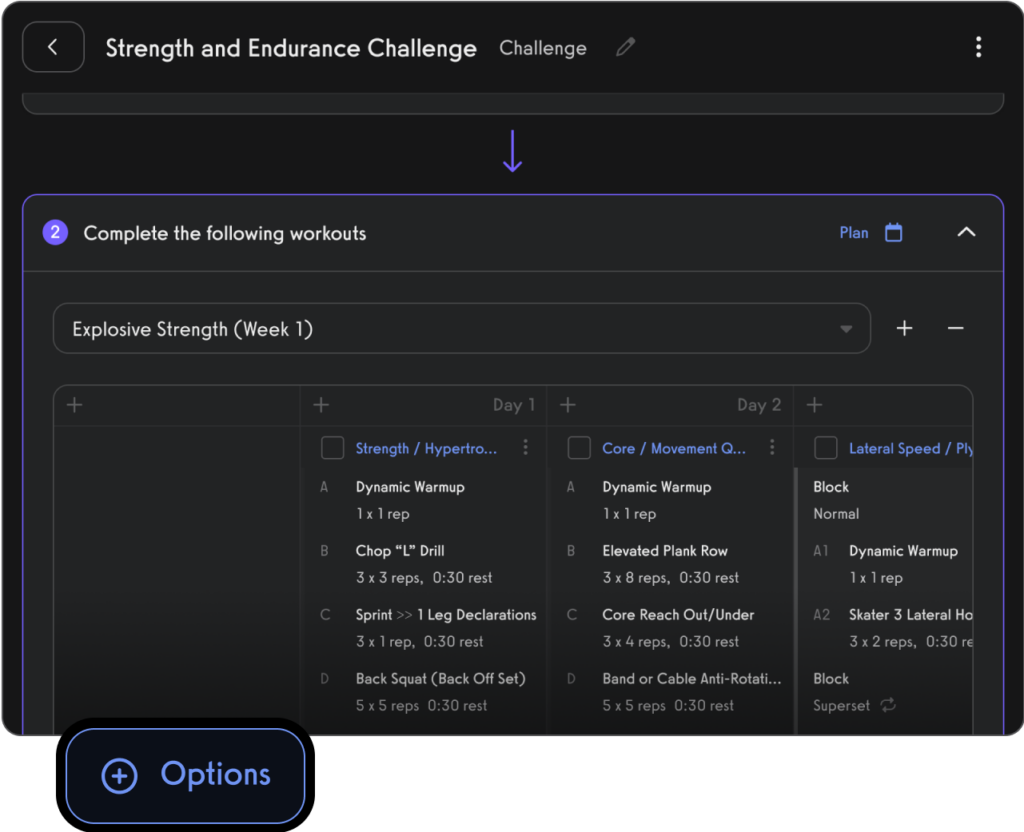
Process payments for open gym, classes, and personal training.

Communicate with gym members, athletes, team members, personal training clients, class members, parents, and dependents via SMS, email, and in-app push notification.

View performance over time, track personal records, and other fitness stats with performance reporting dashboards.
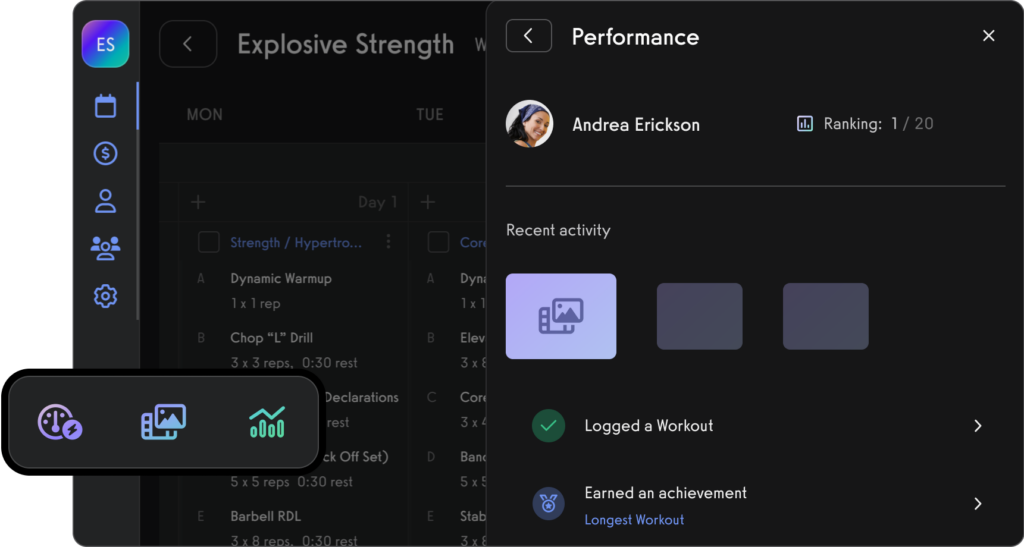
And of course, view all of your fitness business reports easily too.

All from your custom-branded fitness apps (Read More: Best Gym Mobile Fitness Apps Software)

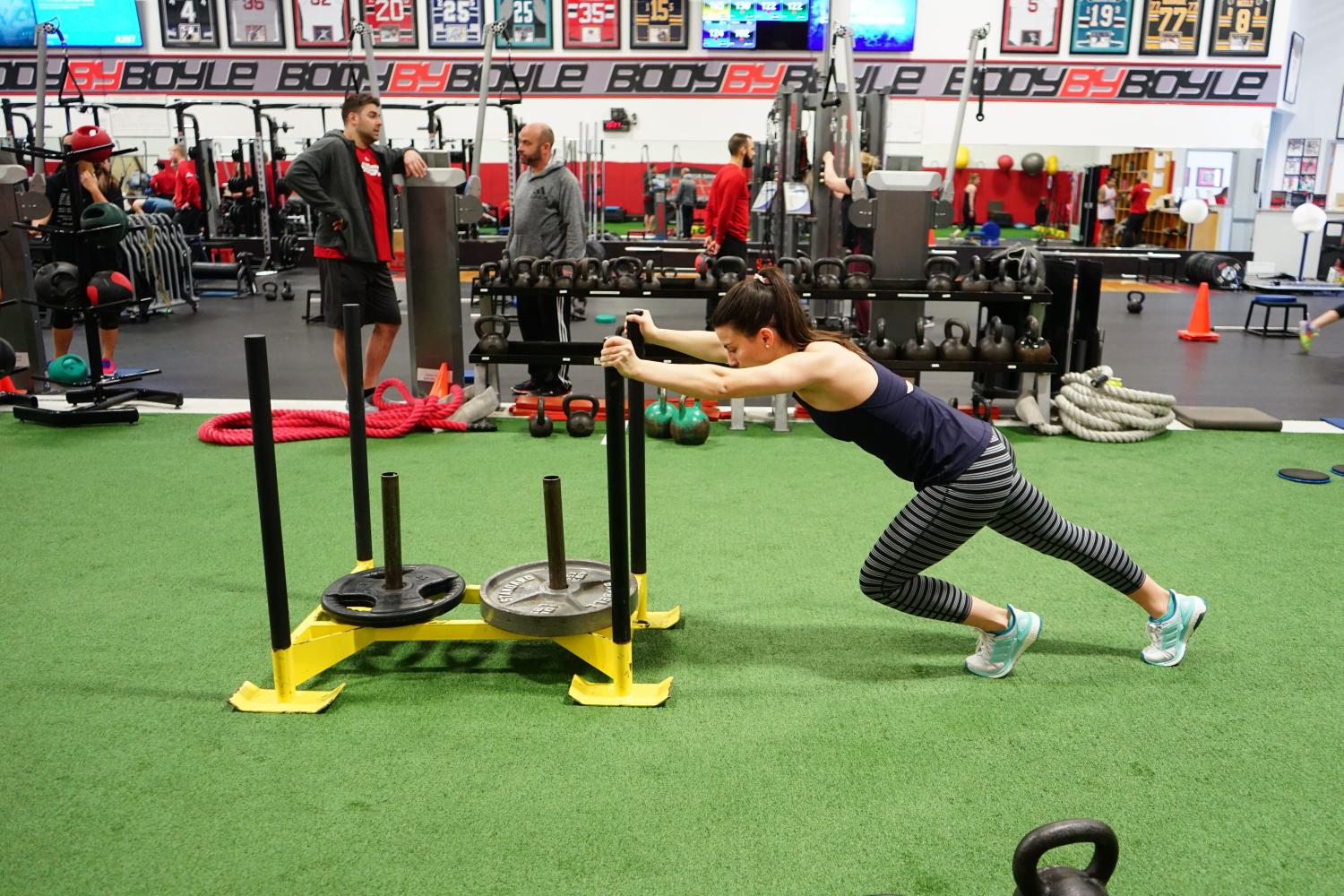
Want to learn how your fitness business can take it to the next level? Get a demo now!
References:









